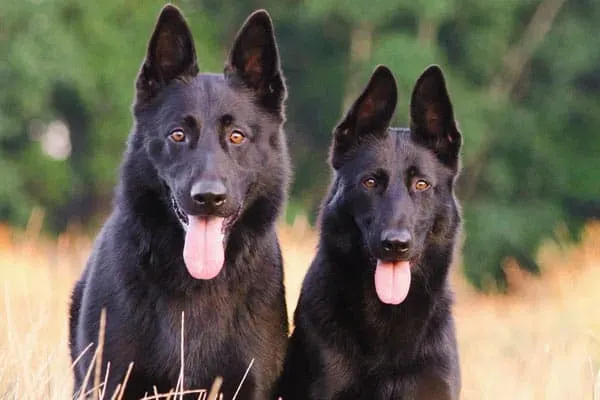Black German Shepherd: How Are These Dogs So Rare?
What is the first color you associate with the German Shepherd? If you are like most US owners, it is probably black and tan.
And if you were stalking the show circuit, you would think black and tan, and more specifically, the classic saddle markings and dark facial mask.
However, if you were on the market for a working dog from Germany, you might be envisioning a dark sable or even a solid black dog.
How is the black German Shepherd different from any other color German Shepherd? How is it unique from other breeds like the black Lab?
You could describe a black German Shepherd as the standard solid black Shepherd, the dark sable dog that is mostly black, or the black bi-color German Shepherd who may only have a suggestion of brown points.
However, black also includes its dilute forms of liver and blue in the German Shepherd. Solid Black German Shepherds result from a recessive gene.
Near-black German Shepherds often appear that way because of the effects of modifiers and masks on brown colors.

How Do Agouti Colors Relate to the Black Gene In German Shepherds?
A brief review of color genetics and pigment is helpful to more easily understand how German Shepherds acquire a solid black coat.
Genes responsible for coat color dictate how eumelanin, the blacks and browns, and pheomelanin, the reds, and yellows, express themselves.
German Shepherds mostly obtain direction for their color and pattern from a series of genes called agouti. Tweaks in distribution and shades come from modifiers and other series or loci.
Agouti or “A” Locus
– “Ay” or “ay” – fawn or golden sable – Fawn is not a German Shepherd color.
Historically, scientists have thought of golden sable as dominant over other German Shepherd agouti colors, but recent studies seemingly refute this or argue a more partial dominance.
Often a predominantly red or yellow sable color but can display a lot of blacks.
– “aw” – wild sable – Wolf gray of many Shepherds; also called agouti; individual hairs are banded with two or more colors
– “at” – tan-pointed; new genetic studies reveal any black and tan dog is tan-pointed whether a saddle, extended blanket, or bicolor Shepherd. Modifiers, the black recessive gene, and the tan creeping gene all influence how much tan a German Shepherd has, according to Ddr-k9.com. (*link removed)
– “a” – recessive black – solid black dog
How Do Dogs Get Black Coats
Genetically, dogs are black based on what genes do at two locations depending upon the breed. Any Agouti expression depends on the “K” and “E” locus.
– Dominant black – “K” – also affects brindling in certain breeds; Great Danes, Pugs, and French Bulldogs, which can all be fawn, brindle, or black.
German Shepherds are always “ky/ky,” meaning no expression of dominant black.
– Recessive black – Agouti “a”
– Modifier – “E” locus determines if a dog can express black pigment; Any solid color German Shepherd, including black Shepherds, are “Em/e,” “E/e,” “E/E,” or “Em/Em” at the “E” locus.
“Em” denotes a black facial mask but can also result in masking throughout the body.
An “e/e” dog will be red or yellow. In the case of the white German Shepherd, where pheomelanin also becomes masked, the dog will be white or cream.

Black Takes Various Forms In German Shepherds
When you think of a black German Shepherd, you most likely picture a solid black dog and maybe occasionally a bicolor Shepherd.
However, the color black also plays a role in black and tan and sable coats.
Black and Tan
A recessive gene “at” on the Agouti locus affects the appearance and prominence of a black saddle present in so many German Shepherds.
Experts say this gene with separate modifiers either causes a Shepherd’s black to recede or her tan markings to spread.
The saddle pattern receives input from the RALY gene.
Evidence of color pattern change occurs in black and tan puppies which are typically born mostly black and develop tan markings that spread as the pups mature.
Sable
Incomplete dominance of the agouti or “A” series and different modifiers may account for the variations in sable patterns and the amount of black coloration.
Patterned sable, which is a brownish dog displaying a non distinct saddle, may result if a German Shepherd carries the more dominant “aw” gene combined with the “at” allele.
A very dark sable Shepherd may lead from overactivity of the masking gene “Em” on the “aw” expression or from black tipping or shading on an “ay” dog.
As a refresher, “aw” is a wolf gray or wild sable, also known as agouti. German Shepherds who look like wolves or coyotes are often of the “aw” genotype.
German Shepherds who are “ay” are golden or red sable, which includes shaded, tipped, and clear classifications.
Shaded sable Shepherds can have extensive black throughout their coats. The order of dominance of “ay” in German Shepherds is no longer clear, but it is rarer than the other agouti series colors.

Bicolor
It is not uncommon for people to incorrectly identify a bi-color German Shepherd. Bicolor German Shepherds are black dogs with minimal tan points.
Like Rottweilers or Dobermans, they have tan points above either eye. However, they lack any of the other stereotypical parts of the pattern around the cheeks or across the chest.
Many do not even have any markings on their legs.
Bicolor Shepherds may have tan or red points at the shoulder points in front of the chest and on the paws.
A true bi-color German Shepherd should have black heels, so the brown on their paws usually refers to the barest of stippling, or penciling, on the toes.
DNA is the only way to distinguish a bi-color German Shepherd from a blanket back. As Ddr-k9.com mentions, there once was a distinction between saddle dogs “as” and tan point Shepherds “at.”
Since scientists no longer see separating tan-pointed dogs as valid, you must look at the RALY gene to identify a bicolor.
Dogs with classic saddles are “N/N” or normal on the RALY gene, meaning the German Shepherd has two intact “creeping tan” genes.
Bicolor shows a duplicate mutation, “I/I,” on the RALY gene, which prevents tan from spreading during maturity.
Moreover, according to Blackthorn GSD, masking modifiers control how many brown points “bleed-through” and how dark a bicolor dog will be.
Dilute Colors
Blue and liver are black-based coats.
Blue
Blue is an expression at the “D” locus of any color German Shepherd.
The “D” locus also has the nickname dilution or bluing gene and has the effect of partially diluting or muting a black coat, causing a charcoal gray to steel blue color.
Dogs with normal colors are dominant “D/D” or “D/d,” while Shepherds with dilution will be “d/d.”
The “D” series affects eumelanin and, thus, eye color, paw pads, eye rims, nose, and lips. Blue dogs have amber, yellowish, gray, or bluish eyes, and a lighter nose.
Dilution affects any black color, so a wild sable can be blue-tinted with a genetic coding of “Eeawawdd”. In simple terms, this means “can express black, homozygous wild sable, recessive dilution blue.”
You may see German Shepherds who are solid blue, blue and tan, and blue bicolor, all for the same reasons as their black counterparts.
See also: German Shepherd Blue Heeler Mix
Liver
The liver, like blue, dilutes black coats. However, the liver color is distinct because it completely disrupts eumelanin, leading to chocolate or reddish-brown coats.
Similar to blue dogs, liver Shepherds have light-colored eyes, usually displaying an amber or yellow color.
Since the liver replaces black, affected dogs can be solid liver, liver, and tan, liver bicolor, or liver sable.
Liver reflects an expression at the “B” locus where most dogs will be “BB” or “Bb” and liver German Shepherds will show the recessive genetic combination “bb.”
Isabella
Surely you are familiar with the silvery color of most Weimaraners. That almost-lilac shimmery look is what breed fanciers refer to as Isabella. In some breeds, it is lilac or silver.
Isabella Shepherds have a dilution at both the “B” and “D” locus and represent a muted liver color.
Genetically, the Isabella German Shepherd is “bbdd.” These unusually-colored dogs have light-colored eyes that are often a paler shade than their liver peers.
Summary – Dispelling Popular Misconceptions
Many times when we are unfamiliar with something, we construct an enormous volume of theories about the subject.
Often, our beliefs do not have much basis in science, but eventually, they become part of accepted and citable references. The following are true.
- Black German Shepherds do not suffer any more health issues or coat problems than any Shepherd – hip and elbow dysplasia, bloat, allergies, Pannus, bleeding disorders
- Black is not a fault or a disqualified color in the show ring for German Shepherds. Black is often not a preferred color.
- Darker colors are more common in working lines than show lines of German Shepherds.
- Black German Shepherds are born black.
Solid Black German Shepherd
Notice how the form of a black German Shepherd is like any other German Shepherd.
Black Puppies are always black while black and tans have tiny spots of color under their tails and possibly other places if you look hard.
Black Sable German Shepherd
An interesting phenomenon is black sables are born light and darken while black and tan Shepherds start dark and see their black recede.






























